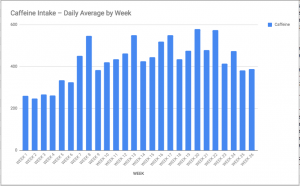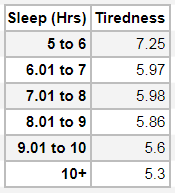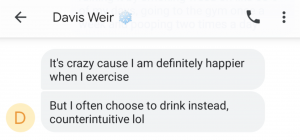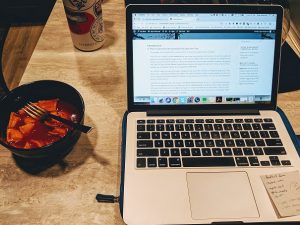Introduction
Or, The Significance of Certain Numbers
The number 182 is significant for a large number of reasons to a large number of people.
If you are, for instance, a Greek basketball fan, your brain may associate that number first with the number of games in a Greek Basketball League season. To the minority of the readers of this blog who do not fall into that group, it’s also the number tacked on at the end of a popular musical group’s name and, similarly, that group’s first album. If you’re former Roman Empire Marcus Aurelius, the deepest connection to 182 you have is likely a somber one, as that was the year of your daughter’s death (RIP).
As I don’t fit snugly into any of the above categories, and also as the one who is writing this blog post, I most fluidly draw a connection between the number 182 and the number of days in approximately one half of a year. I’ve experienced approximately 52 half-years in my 26 years on this planet, so I have become adequately familiar with the subject.
And while 182 may seem like a lot of days, in the grand scheme of things, it’s not — in fact, scientists estimate that since the beginning of time, there have been over one thousand days! Looking at a half of a year –182 days– through other lenses can shed additional insight on and new perspective on what makes a half of a year. Thanks to scientists and mathematicians, we know that a half a year broken into hours is a whopping 4,380. In minutes, it’s 262,800, and in seconds, 15,768,000.
Thanks to me, we know that broken into milligrams of caffeine, it’s 70,860.
.
Background
Or, What I’ve Spent the Last 6 Months of My Life Doing
About six months ago when visiting my dear friends Tom and Shelby in San Francisco, an idea was presented to the group in passing. This idea wound up becoming first an hour-long, then day-long, then trip-long conversation that saw us each pose our own questions and take stabs at answering them. The concept was “lifestats” – how much of one thing one person has done over the course of his or her life.
“If you laid every cigarette I’ve ever smoked end to end, how long would it be?”
“If I peed all the pee I’ve ever peed into a pool, how much would it fill?”
“If I poured all the beer I ever drank out onto this floor, how high do you think it would rise?”
We debated whether a lifetime of Tom’s beer poured in his apartment would be ankle deep or knee deep (Tom drinks a lot). We debated one room vs the whole apartment, even whether things like furniture would be removed from the rooms for the purposes of these hypotheticals. We rarely reached conclusions or consensus answers, but it didn’t stop us from spending many evenings talking about how much of x we had done in our lives.
I fell in love with the concept, and so just like that, San Francisco became the birthplace of this idea–putting my life into numbers. Though it was only half of the equation in this case.
The other half stemmed from my work, which helped me realize how much I love spreadsheets and numbers. Though spreadsheets and numbers certainly don’t make up the largest part of my job, I’ve taken it upon myself to try to create sheets that would help me do my job a little easier, a little better, or in most cases, just a little cooler looking.
In my personal life, I’ve used spreadsheets to crunch numbers pertaining to how good I am at Battlefield (not very), which character I can kill people most efficiently with in Twisted Metal Black (Spectre, surprisingly), what sport I lose the most on when gambling (baseball), what team I’m best at picking over/unders for (the Mariners, who I can correctly peg at a 71% clip) and even how poor of a shooter I am from different spots on a basketball court (universally, the answer is “very”).
It’s a weird hobby, admittedly, but it’s something I enjoy doing. To me (and millions of other people), I find more value in seeing things displayed as numbers. Sometimes it helps to quantify things that are not naturally quantified – you’re unhappy, but are you a 2, or a 4 out of 10? You’re tired, but how tired? What’s the number?
Other times what I’m measuring is already quantitative, but simply hadn’t been measured before – you’re a bad free throw shooter, but are you worse than my 55% free throw shooting?
Contextualization of numbers is huge for me. It’s a reason I love tinkering with formulas at work to predict how much of my team’s revenue we’ll be retaining and how much we’ll lose, or what tier of service my team is most effective at retaining clients on.
The ability to create spreadsheets to track this information and give some meaning to otherwise qualitative or uncounted data is, for me, enjoyable.
So if San Francisco is the father to my LifeStats tracking, then my love of spreadsheets is the mother (or, perhaps in this case, the second father).
So when I returned from that San Francisco trip on or about April 2, 2018, I made a bold decision. A decision that will likely change the course of human history (or perhaps just the status of my relationship in the future). I decided to start tracking my life in an Excel spreadsheet.
.
Big Data
Or, What I Tracked for 182 Days
Once I knew that I’d be tracking most every facet of my life, the next logical step would be to define what I meant by “most every” in the first clause of this sentence.
I started by focusing in on a few goals that I had – namely reading and writing more, going to the gym more frequently, and limiting my caffeine intake (Lol). I placed these (and some others) into three categories on my sheet – dubbed at the time of the sheet’s creation, That Good Shit, That Bad Shit, and That Overall Shit.
That Good Shit
1. Pages of books I read each day
2. Pages of written words I had created
3. Number of times I went to the gym
4. How many consecutive bicep curls of a 20-pound weight I could do
That Bad Shit
1. Caffeine intake per day, measured in milligrams
2. Number of sports bets placed per day
That Overall Shit
1. The time I went to bed (the previous evening)
2. The time I woke up (that morning)
3. Hours of sleep
4. How tired I felt on a scale of 1-10
5. My Mood on a scale of 1-10 (This was later broken into a morning mood and an evening mood)
6. My weight each morning
7. How much money I spent each day (Later nixed in favor of a separate budget tracking sheet)
The methodology of the above was fairly simple. For most, these were just counting (or mathematics, for which I utilized my smartphone’s built-in calculator application – the new Google Pixel 3 in stores now [ad]). I counted the number of pages I read and wrote each day and logged them. I put a “1” in the sheet if I went to the gym and left it blank (or put a “0”) if I didn’t.
I’ll dive into each specific category and the methodology of them into the next section. Now would be a great time to quit reading this if you’re not interested in the actual numbers, and had just been reading this blog post to see if it was a suicide note or strange, pathetic plea for help.
.
Big Data 2: The Actual Data
Or, The Section That You Likely Came For, If You Came At All
That Good Shit
Pages Read
I’m starting with the piece of data that is likely not particularly enthralling (though, to be honest, none of it really is). This data represents only pages of books that I read throughout the last half of a year, not online articles or pages of the Dictionary.
Over the course of the 182 days, I read exactly 1,907 pages, good for about 10.6 pages a day. That number indicates I fell 14.4 pages short of the 25 pages/day goal that I set for myself, but I’m an underachiever, so that’s that. The most I read in a single day was 156 on August 12; the least, predictably, was 0. Those 1,907 were spread across 69 (nice) days of active reading (ie. days where I did read at least one page); this means that on days that I read, I typically read about 28 pages.
This also means that of the 182 days in the half of a year I used this sheet, I did not read on 113 of those days, falling 25 pages short of the aforementioned goal. In short, I read at least a page on about 38% of days in this half of a year.
On average, I read the most on Mondays (about 19 pages/day), and the least on Fridays and Saturdays, because I am not a nerd. This information is neither useful nor interesting, but I had the formula set up to calculate all of these stats depending on the day of the week, so you’ll see this a lot.
Pages Written
If you read the “Pages Written” title of this section and thought to yourself “that doesn’t seem like the most efficient way of tracking your writing,” then congratulations, you’re correct, it’s not. As you’ve likely realized by this point, I am neither a scientist nor a smart man, but we’ll make do.
Over the course of 182 days counting how much I wrote, I accumulated a whopping seven written pieces across four writing sessions. While you may find these numbers implausible, you would be surprised what the human body can do when pushed to its limits.
One of those days was April 30th, a day that saw me not only write three pages, but also read 28 and go to the gym. This is sufficient to determine that April 30th was likely the most productive I’ve been to this point of my life. Perhaps this will turn into a suicide note after all – stay tuned.
Gym Attendance
If you thought that writing four times over the course of 182 days was pathetic, strap in! During the course of a 182-day span, I went to the gym a grand total of 18 times, or once every ten days.
My gym attendance started “strong,” as I went 10 times in April. From there, things get worse, as I made the leisurely 15-minute drive a total of eight times after that.
Interestingly, despite what BIG FITNESS may tell you, I was, on average 0.06 happiness units higher when I did not attend the gym, averaging a 6.42 on days I did not give in to the sweaty giant’s allure, and a 6.36 when I did. While I am not a scientist (I went to a state school and majored in Communications), I am inclined to declare a 0.06 happiness unit delta with a sample size of 164 on one side and 18 on the other decidedly non-significant.
A final note details my want to better myself – as I reached my peak weight (more on this later) in mid-June, I was no more motivated than usual to go to the gym; in fact, I went to the gym twice the week prior to hitting my peak weight, but zero times in the proceeding three weeks.
Bicep Curls (or “REPZ”)
If you haven’t picked up on the trend that my performance in the “Good Shit” categories would be underwhelming, let this be the final clue in that long, winding mystery.
I did as many successive curls (alternating arms) as I could on ten occasions, lumped in two five-day sets, one in late July and one in early September. The most curls I could muster was 61, an event that occurred on my first fucking attempt, successfully disproving the notion that exercise builds muscle over time. I averaged the most on Monday (61) and the least on Friday (41), while Tuesday and Wednesday yielded identical numbers (46.5). This data proves succinctly that people are strongest on Mondays, very weak on Fridays, and that there is no discernible difference between Tuesdays and Wednesdays to the point that one of these days may actually not even exist.
That Bad Shit
Caffeine Intake Per Day (Milligrams)
The first category that might actually yield some interesting (if not frightening) results. For some context, it may be necessary to read this blog post in which I discuss my debilitating caffeine addiction and contains information that I am potentially more ashamed of than the fact that I wrote down my life in a spreadsheet for half of a year.
For some more unrequested context, I start most mornings with a caffeine pill, a habit I got into after reading about it on Reddit one time, I think. I have an initial alarm set for about 20 minutes prior to the time I actually need to get out of bed; when the alarm sounds I get up, take a pill, and go back to sleep. When I get up 20 minutes later, the pill has started to kick in, and I’m more awake than I would be without it. Genius, certainly. A sign of addiction, absolutely.
Now, for the numbers. I averaged a robust 424 milligrams of caffeine per day over the course of half a year. This is the (approximate) equivalent of about four cups of coffee a day. The most I consumed in one day was 800 milligrams, and the least was 100 milligrams. What this means in non-scientific terms is that not once between April 2, 2018 and September 30, 2018 did I go a day without caffeine.
The maximum – that is, consuming 800 milligrams – occurred just once, on August 13. This was the afternoon that I failed to realize that the “Crazy Caf” K-Cups we had in our office contained 400 milligrams of caffeine each before I proceeded to drink two. Looking at other stats that day shows an otherwise average day. I got about 6 hours and 45 minutes of sleep the night before (less than my average of 7.994) and rated my mood as a 6 in the morning and a 5.5 at night.
On three occasions I consumed just 100 milligrams of caffeine, twice on Sundays and once on a Tuesday I spent in Philadelphia at a job fair and thus not near a ton of coffee. On those days, I averaged a 6 on my 1-10 tiredness scale (more on this later), which makes it difficult to say whether I was not particularly tired despite not drinking much coffee, or that I didn’t drink much coffee because I wasn’t tired.
Broken down by day of the week, I consumed the most caffeine on Mondays and Fridays. This makes sense – I’m likely still on the weekend-sleeping-in hangover come Monday mornings and need that extra pick-me-up. On Fridays, I tend to consume more after work to keep me going into a night of partying and/or watching television on my couch. I didn’t track the number of times I did those two activities, so I think it’s safe to conclude that I partied a ton and am not lonely, despite everything this blog post might imply.
I consumed the least on Sundays, which also tracks in this case; without work I’m able to nap whenever I’d like (they hate when I do that at work) and therefore don’t need anything to get me through the day.
There was a very light positive correlation (0.29) between caffeine consumed and how tired I felt – ie. I consumed more caffeine on days that I felt more tired. Likewise, there was a very light negative correlation (-0.26) between caffeine intake and my mood in the morning. These make sense thinking purely logically, and are backed up by the anecdotal evidence that caffeine does not wake me up, it keeps me at a sense of stasis. I do not feel energetic when I drink coffee, I chug coffee when I’m tired so that I do not fall asleep wherever I happen to be standing.
While the above concludes my analysis of my caffeine intake, one more note is necessary here – my intake was higher for periods, but has come down recently due to my girlfriend expressing “concern for my health.” Out of respect for her, I limited my intake to the daily recommended maximum of 400 mg. To the right, you’ll see a chart that details my average daily caffeine intake, broken down by the week.
Sports Bets Placed Per Day
Fear not – because after that absolute whopper of scientific excellence in the above section, this one will be significantly shorter. Why, you ask? Because when I hit –$1,000 in career sports betting earnings, I decided to call it quits. If it is or was not apparent at first glance, that is in fact a negative number.
This concludes my analysis of my sports betting habits, which can be described as “poor” and “potentially addictive.”
That Overall Shit
What Time I Went To Bed, What Time I Woke Up, and How Much Sleep I Got
As this blog post approaches 3,000 words, I figured making good (better?) use of my words and your time would be warranted, so I’ve combined numbers one, two and three from the “Overall Shit” category, as each directly related to the time I spent asleep.
For background, I am asked to show up to work at 8:00 am every weekday. Because I live a five-minute walk from work, I don’t need to be up until about 7:15 or 7:20 every morning, giving me enough time to shower and leave for work by about 7:50 am. However, I began making a concerted effort to get up earlier than 7:15 to give myself some me-time in the morning (typically spent browsing Reddit and/or watching Workaholics).
As I alluded to earlier, I averaged 7.99 hours of sleep per night across the 182 days I tracked my habits. Given that the recommended amount of sleep according to a quick Google search is 8 hours, I would say I’m doing pretty stellar in this regard (though my average of about 6 on the tired scale suggests I could use a bit more).
This number is skewed, however, when you apply advanced scientific and mathematical compound Keplar layering to the data, which reveals that I slept on average 7.44 hours during the week, and 9.46 hours on weekends.
Though I was once accustomed to operating on 5-6 hours of sleep a night, those days are behind me now. Only twice did I get fewer than 6 hours of sleep, the fewest clocking in at 5.5 hours on the evening of Monday, September 2 into Tuesday, September 3.
Breaking down that evening further shows I had just 200 milligrams of caffeine Monday, but managed to stay awake until 12:30 that evening, which is fairly irregular. Digging deeper, I noticed that I had woken up at 10 am that Monday, indicating I was either phenomenally late for work, or I had the day off. Given that I still have my job, I’ve assumed it to be the latter. I woke up at 6 am on Tuesday and reported myself as a 7 on the 1-10 tired scale. As it turns out, 5.5 hours of sleep is rough, but not that rough.
The most sleep I got in one day was a mind-numbing 11 hours, a feat I “accomplished” an incredible 8 times. On average, those mornings I rated my mood at a 6.25 (above my average of 6.12), proving scientifically that I am generally happier when I spend less of a day conscious. Ironically, this realization will likely bring my mood down a bit. Lending a bit more authority to the scientific notion I am laying out that getting more sleep is better for you in every possible way is the fact that I was also less sleepy on average (5.44 vs 5.91 overall) on days when I slept 11 hours. Take that people who claim oversleeping makes you tired, you idiots.
How Tired I Was
Typically I measured this at the end of the day with a retrospective look on my day. Was I struggling to keep my eyelids open, or too busy to notice how tired I was? Did I feel energetic throughout the day (no) or fairly lethargic.
This was rated on a simple 1-10 scale. When I created this form, a 1-10 scale seemed logical at the time; it’s a classic means of measuring something, you know? But as I quickly discovered, I was rarely a 3 or an 8, and never a 1, 2, 9 or 10. There was a certain aversion to using the extremes on either end, as I tried to treat those as “so tired you literally fell asleep standing up” ranges, which is an obvious drawback, and the reason I switched to a 1-5 scale for all number-ranged stats in my second, ongoing iteration of LifeStats.
That being said, putting flaws aside and looking at the numbers, they paint a picture of a man who is surprisingly not particularly sleepy. Throughout the data collection and scientific analysis period (DCASAP), my average sleepiness factor (ASF) was 5.91, which seems right around (albeit a bit above) average. But because I entered this considering 5 to be a day where I was my average level of sleepiness, I was, on average, a bit sleepier than what I considered to be “normal” sleepiness level. Which means, statistically speaking, what I thought was “normal” was not “normal” because 5.91 (or more sleepy) is actually my “normal.” Science is amazing sometimes, folks.
Chunking sleep into 1 hour windows (5-6 hours, 6-7 hours, etc) though REAL and AUTHENTIC science, I have discovered what may be one of modern science’s greatest breakthroughs: the more sleep I got, the less tired I was the following day. Don’t believe it? See the science chart below.
If you’re interested in the raw, unedited data that contributed to the above graph, look at the chart to the right here, where the numbers were arduously broken down and charted for you, the reader.
Was the fact that my tiredness waned as I got more sleep due to the fact that, on days I got over 10 hours of sleep I had fewer responsibilities and therefore could lounge around a bit more and feel less pressured to be awake? Perhaps, but equally as plausible, perhaps not. I will leave that determination to the suits at the New England Journal of Medicine.
In terms of a day-to-day outlook, none of the results were particularly enlightening – I was least tired on Sundays (God bless) and the most tired on Tuesdays which I can not rationally explain, and is likely the work of powers higher than science.
My Mood (AM & PM)
When I started keeping this stat, the initial plan was to use this as a rough means of measuring how happy I was – was my mood better when I got more sleep? On a specific day of the week? When I was going to the gym regularly? The above questions were hypotheticals, so while you cannot answer them, science can attempt to.
I typically measured my mood at the end of each day in a similar fashion as mentioned above with tiredness. However, after some time I began breaking mood into AM and PM mood – the former measured right when I wake up, the latter when I go to bed. Would a better scientist also institute some mid-afternoon mood gauge? Almost certainly not, because a better scientist wouldn’t be doing virtually anything I am doing or have ever done with my life.
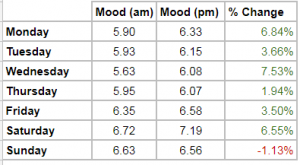 I’ve addressed how my sleeping habits affected my mood above (a short recap: more sleep = happier Dr. Ryan), so we’ll gloss over that. Generally, I was happier in the evenings (6.42) than I was in the mornings (6.12), which isn’t surprising. The effect was most pronounced on Saturday – easily my happiest day overall – and Wednesday, when the morning is like, “Shiiiit it’s only Wednesday” but the evening is more like “okay well, at least tomorrow is Thursday (Kingston & Geiger, 2017).” The only day that saw an average dip in happiness as the day went on was, predictably, Sunday.
I’ve addressed how my sleeping habits affected my mood above (a short recap: more sleep = happier Dr. Ryan), so we’ll gloss over that. Generally, I was happier in the evenings (6.42) than I was in the mornings (6.12), which isn’t surprising. The effect was most pronounced on Saturday – easily my happiest day overall – and Wednesday, when the morning is like, “Shiiiit it’s only Wednesday” but the evening is more like “okay well, at least tomorrow is Thursday (Kingston & Geiger, 2017).” The only day that saw an average dip in happiness as the day went on was, predictably, Sunday.
Next, I decided to take a look at how going to the gym affected my mood. On days that I went to the gym,
my evening mood was, on average a 6.36, lower than it is on days that I did not (6.42). This data should be enough for psychologists to stop telling me I’ll be less depressed if I exercise more. (Edit: Upon doing a reread, I’ve realized this data is in here twice, which is a mistake. But I did get the same numbers both times I did the calculations, which is good).
Weight
This is the section you’ve undoubtedly been waiting for – you’ve been reading this blog this whole time just wondering how fat I was. Before I answer the question, I’ll cover methodology. I measured my weight with a bathroom scale (genius, I know) every morning. And when I say every morning, I mean about 47% of the time, because I forgot to weigh myself the other 53%.
My weight was easily the hardest thing to remember to do, despite my various attempts to remind myself to step on the God damned scale in the morning (fig. 1). To keep things accurate and to get approval from the Institutional Review Board that oversaw this experiment, I decided to only record when I weighed myself first thing in the morning and when completely sans clothing (Fig. 2).
Despite my lack of data regarding my various weight fluctuation, I can tell you that through the last half of a year, I’ve averaged 152.33 pounds on the dot – certifiably not fat.
The heaviest (read: most powerful) I was in these 182 days was 156 pounds, while the lightest (read: most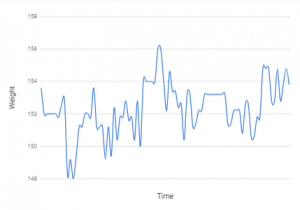 agile) was 148. An 8 pound fluctuation is perfectly healthy and reasonable according to what I’m just thinking right now. To the right, you’ll see a chart of my weight over time, which is sort of flat looking given that it didn’t change much.
agile) was 148. An 8 pound fluctuation is perfectly healthy and reasonable according to what I’m just thinking right now. To the right, you’ll see a chart of my weight over time, which is sort of flat looking given that it didn’t change much.
One tangible takeaway from my weight data is that I was skinniest on Saturdays, so if you’re a wrestler or boxer who is trying to make weight, kindly ask the ref to move the fight to a Saturday, when you’ll be skinnier.
Finally, what you may notice is that my very first weigh-in came in at 153.6, and my final at 153.8, just a 0.2 pound difference. This is a great metaphor for the meaninglessness of life and a fantastic signal that this whole thing started where it finished.
.
So, What Now?
Or, The Future of LifeStats
I can say, looking back on the data I’ve crunched above that I’ve learned next to nothing about my habits. That wasn’t the point, though. I did this because it’s fun, and because I like numbers. I saw some cool numbers while typing this absurdly long post out – cool numbers like 6.21, 153.8 and 14 – all classics.
It’s important to remember that the numbers and calculations above do not represent real scientific data – as I
mentioned above, I am not a scientist, I’m a guy who’s writing this blog in between bites of Chef Boyardee (fig. 3). No readers should attempt to push their bodies to the limits that I did. If you do, the risk is your own.
Since closing out 6 months of LifeStats, I’ve far from given it up. In fact, I’ve revamped the sheet in its entirety, dropping some things (REPZ) and adding others, such as how many bowel movements I have each day (gross, but also highly scientific). I’ve made tweaks to how others are measured, changing the 1-10 scales for my mood and level of sleepiness to simpler 1-5 scales representing Bad, Below Average, Average, Above Average, and Great.
I’ve also changed bets/day to money lost on bets – despite me mentioning giving up on sports betting, I’ve crawled back in the form of daily fantasy leagues, where my losses can be controlled monthly (so far about a week and a half in I’m down $19).
I’ve added binary yes/no fields for some of the activities I’ve commonly done throughout a day that could feasibly affect others – video games, napping, seeing my girlfriend and writing (removing pages written). I’ve also added weekly goals – three small to medium sized endeavors I’d like to complete each week – with the purpose of looking back at how I set those goals and ultimately how successful I have been. Take a look below at the old and new versions of my LifeStats sheets, for some perspective on how they’ve changed.
And now, about 4,600 words later, I can check off one of this week’s goals: “Complete LifeStats blog post.”
- OLD – V1
- NEW – V2
